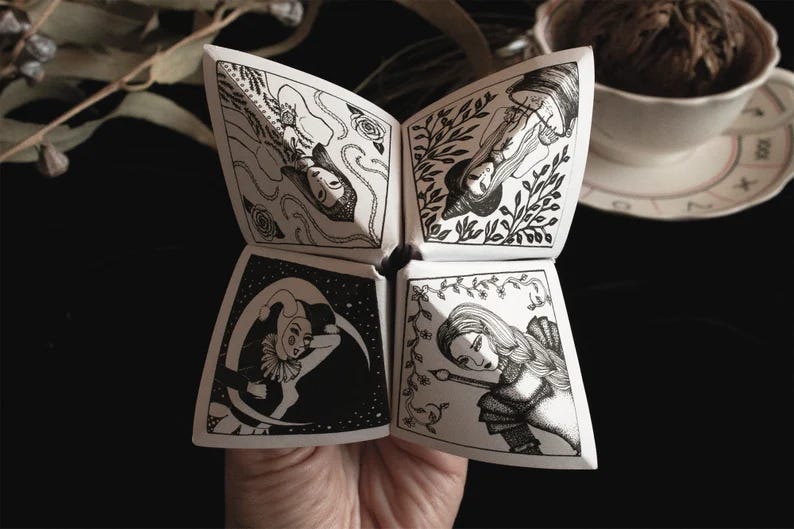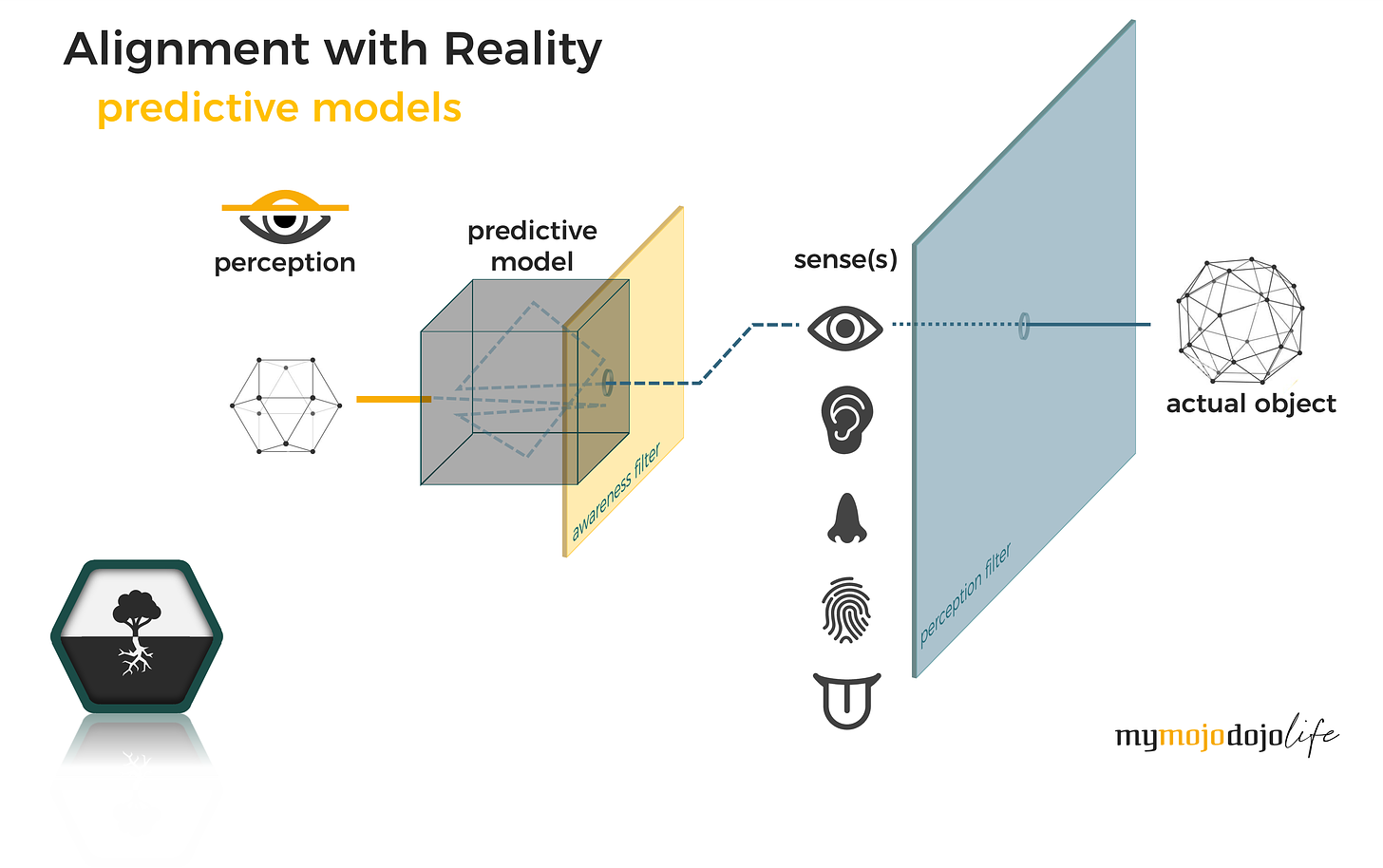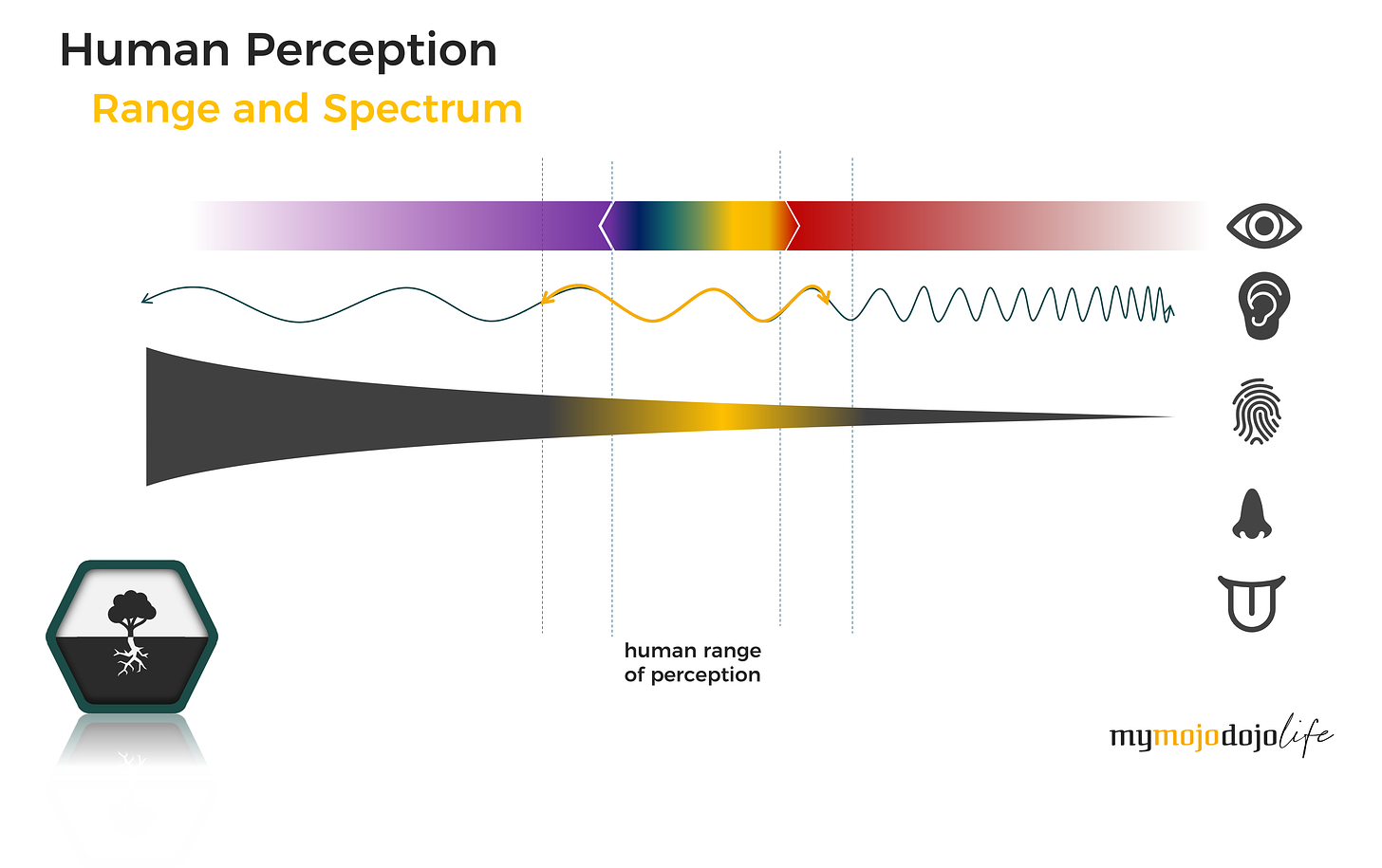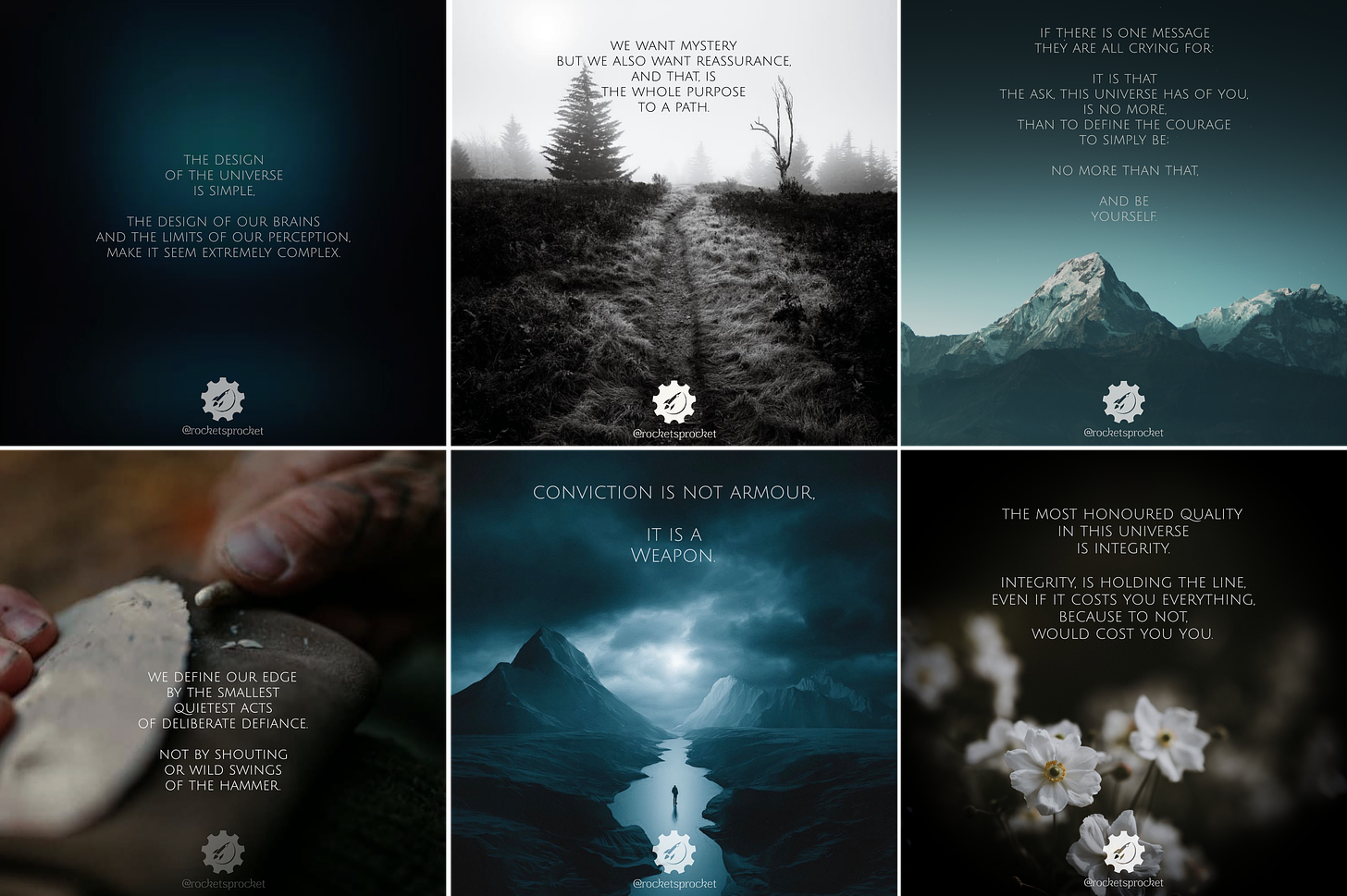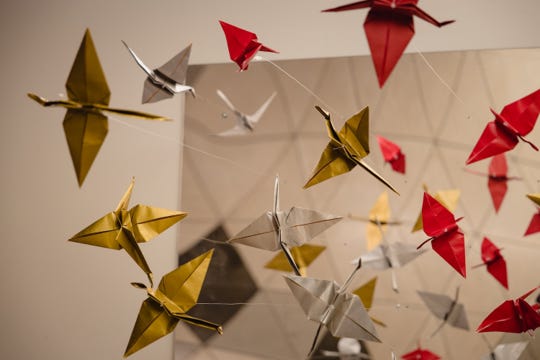The Holographic Nature of Language
We cannot visit worlds for which we do not have the language.
THIS IS ONE OF SEVERAL ‘KEY CONCEPT’ ARTICLES THAT WILL FORM THE CORE OF THE CORPUS OF MY WORK HERE ON SUBSTACK. THESE ARTICLES ARE DESIGNED TO MAKE SOME SENSE ON THEIR OWN, BUT THEIR FULLNESS OF CONTEXT ONLY BECOMES VISIBLE IN RELATION TO THE CONSTELLATION OF MEANING PROVIDED BY THE OTHER CORE ARTICLES WHICH WILL BE NOTICABLE BY THE ‘CONSTELLATION KEY’ ICON YOU SEE ABOVE. (THE HEPTAGON FORM OF THE ICON DENOTES A MORE TECHNICALLY DENSE ARTICLE.)
“Our Language is too small for the territory we have already entered.”
I heard these words via David Whyte, which by his own admission were not his own, being something he had overheard someone say, who themselves did not realise the full implications and poignancy of their words.
Life is very much a conversation. Our entire internal experience is us, in relationship with ourselves. It is through this that we may begin to understand how non-individual we are. To be an individual, means to be something that cannot be divided into lesser parts. We are all more of a ‘we’ than an ‘I’, and the language we hold that internal conversation in, is too small for the infinitudes we contain.
We are languishing in a crisis of meaning. We have created our tools and systems, and they in turn have created us, and are determining who we are becoming. We inherited a legacy of old ideas, framed in old language, the secret foundations of which are superstitions and archetypes, hidden together deep within the murky shadows of our psychology and at the same time lying out in plain sight, in the language and symbols we use to describe our world, and the projects of our lives.
The language and symbols lend themselves to predictive models of a world, its rules and how we fit into that, models which are proving to be inaccurate and far to simplistic to make sense of the complexity and overwhelm we are bombarded by. As we attempt to traverse our modern landscape of demand and intricacy which has accelerated to the circumstance we find ourselves in now.
The world we believe still exists, is actually in accelerating decline, our ability to parse and integrate what we are experiencing is vastly overwhelmed by the rate at which new, urgent and enticing demands for our attention keep arriving. The more our species peels back the layers of the mysteries of the universe, the more we are able to harness the power we discover. The more of that power we wield, out of step with the necessary and requisite prudence, the more harm we cause to our future selves and species we share this moment with, and along with it the delicate balance of the natural world.
Due to the limitations of our human nature and perceptive and cognitive limits, we have a capacity for almost limitless curiosity and inventiveness flourishing perfectly in the dark umbra of our limitations of self-awareness, sitting always on a blind curve. We are individually and collectively unable to make sense of the road behind, and unable to predict or even discern how our present choices will affect the manner in which we face the road ahead, nor the consequences to our environment that we might cause in our ignorance.
To love without knowing how to love wounds what we love. Understanding is love’s other name. If you don’t understand, you can’t love.
Thich Nhat Hanh
Human history is a long chain of folly stitched together with human resilience and divine providence. The examples of our folly are both embarrassing and near endless. A few sobering reminders of our blunderings in the name of clever progress were hunting species into extinction, introducing germs to the new world and adding lead to fuel. These changed the world we live in, forever, and hardly in wholly positive ways either. This happened because of a ‘smallness’ by which we attempted to hold the conversation.
This is something that is bound, invariably, to keep happening across every arena of human experience, exacerbating our current discomfort and suffering. The same holds true from the intrapersonal private conversation we hold internally, right up to the level of our dysfunctional public discourse -until and unless we can adapt our language and our internal predictive models to suit the wider complexity and nuance we are moving through.
“Our Language is too small for the territory we have already entered.”
Order from Chaos.
Our ability to process and parse the unknown into the known, is what we mean when we use the word ‘Order’.
We impress a sense of order on our worlds, internally and externally, by making sense of the unknown and making it known. We attempt to make things at first recognisable, and then later predictable. To make things recognisable, we name them. To call something by a name, is to be able to recall it. To make things definable and predictable, we need to understand the relationship between Causes and Effects. All of human psychological comfort and power is derived this way.
The converse definition of Chaos, is the arrival of urgent questions at a rate which far exceeds our ability to process, much less answer.
In all chaos there is a cosmos, in all disorder a secret order.
Carl G. Jung
We have opened Pandora’s box, and the box was like a ‘paper fortune teller’, what American school children referred to as ‘cootie catchers’, which was not just a one-and-done opening, but a progressive unfolding.
Pandora is Eve. The opening of the box, was the eating of the apple. The journey human beings are on, is not one of shameful exile, but rather a pilgrimage through Life, to earn our place in the understanding of the Knowledge of ‘Good and Evil’, that is Cause and Effect. This is how man has always taken what was once deemed the capricious machinations of gods and daimons, and slowly made of that chaos and wilderness, an order; we name that which we encounter, and then relate what we name to everything else we have named. This is our language.
In more generic terms, our language, is an organically and clumsily evolved thing, full of double meanings and gaps for which we need to borrow from other languages, like cups of sugar, for things we have no words to adequately describe. Our “modern” language is infused with memes and clichés, technical jargon, and nearly invisible bits of glue and seasoning which hold it all together. While our use of words carry some meaning, somehow, we have lost their deep meanings, which are the connection to our deep psychological archetypes, and to ‘the sacred’.
Sacred does not need to have anything to do with shared ideas of religion or god, or whimsy. It is simply the answered wish to discover something deep, foundational and beautiful about this world and our sense of very private gratitude and belonging we get from that encounter.
The means by which we map out the world we are encountering, and the meaning we are ever able to attach to what is happening right in front of us, is limited by the granularity, the resolution as it were, of that detail, and the resolution of our language.
At the heart of our psyches, we have an innate form of ‘language’ which is more symbolic than literal. All language is simply our fractal approximations of archetype, form, principles and powers and our use of language betrays always our superstitions. This was the ‘language’ to which C.G. Jung and Joseph Campbell subscribed.
We can gain near direct insight to this by showing a series of pictures to a child of a dozen different men in military uniforms, of all ranks and designations: infantrymen, guards, scouts, paratroopers, pilots, sentries, mercenaries… and when asked what each is, the child will simply reply “soldier”.
The child’s resolution is still 16 bit.
We all see the world through the limitations of our own grasp of language.
We don't see the world as it is, we see it as we are.
Anaïs Nin
Imagine finding the television you had as a kid and replacing your current television (or screen) with this older model. The same goes for your current computer screen. Remembering, that at the time you believed this to be the very edge of technology in so far as you understood the context. You did not look at it and pine for the screen resolution and image quality you have today. You simply could not conceive of anything else, except perhaps some newer model a neighbour had.
Now imagine taking that screen and trying to watch your favourite movies, or play your favourite computer game. Or imagine trying to do your graphic design on such a screen now.
The thing is, we are used to accepting the limits we live with, because of the limits of our imagination, and the limits of our language.
As Wittgenstein said: “The Limits of my language define the limits of my world.”
To be clear: none of us actually see or hear or touch the world;
Perception.
Our bodies have senses which relate stimuli through our sensory organs and nervous systems, which are received as electrical signals to our brain, from which we hallucinate the meaning and the context of what we encounter. All our memories and models of the world, reputations of other people, understanding of all causes and effects, are shaped through these imperfect apertures, through physiological and psychological distortion filters, and confirmed or classified imprecisely based on the quality and resolution of our internal existing frame of reference. Our brains are not designed to reach for the truth, but rather to reach for rapid confirmation.
Jim Carey, in his now famous 2014 commencement speech to the students of the Maharishi University, said: “Our eyes are not viewers. They are also projectors that are running a second story over the picture that we see in front of us all the time.”
Our eyes are not viewers. They are also projectors that are running a second story over the picture that we see in front of us all the time.
As it happens, the entire speech is nothing short of incredible; you should take the time to watch it. (I watch it once a year.)
Further to that, what we are able to perceive of the world is a very slim slice of everything there is. I sometimes help break people’s brains by telling them that when a dog or a bee see a sunflower, they do not see what we see, and what is more, the flower is what each sees and something more still, which we cannot comprehend.
Humans typically see colours as a combination of red, blue, and green because our eyes have three types of cone cells, each sensitive to one of these colour components.
Dogs only have two types of color receptors in their eyes, sensitive to blue and yellow. They can't distinguish between red and green. So, when a dog looks at a sunflower, they would likely perceive the leaves as a form of gray or dull yellowish colour.
Bees have a very different visual system. They are trichromats like humans, but their three types of colour receptors are sensitive to ultraviolet light, blue, and green. This means they can see colours in the ultraviolet spectrum, which are completely invisible to us.
Sunflowers, have patterns on their petals that can only be seen in ultraviolet light. These are often called "nectar guides" because they direct bees and other pollinators to the source of nectar in the flower. So, when a bee looks at a sunflower, they would see these ultraviolet patterns superimposed on the blue and green parts of the visual spectrum.
While each organism is perceiving the ‘same’ sunflower, they each only see an aspect of ‘something’ that simultaneously relays a different set of qualia to snakes, birds, bats etc. What really blows our minds is that we were stuck for a while believing we saw the sunflower as it is. The sunflower supports all the relative aspects of perception and is something greater than can be perceived.
Each creature perceives a unique but limited ‘hologram’ based on the specific sensory capabilities of that individual. The sunflower itself, however, existentially represents all these properties and potentially more - it's just that each organism can only perceive a fraction of them.
Reality far, far exceeds perception. The whole far exceeds any singular perspective. The fundamental truth of reality, in any thing or any one we encounter is, by definition so much deeper and more nuanced than we have the senses to perceive or the language to contain.
Holograms.
Holograms are three-dimensional images produced through the interference of light waves. They create the illusion of depth and solidity, allowing viewers to perceive objects or scenes as if they were physically present. Unlike traditional photographs or images on screens, holograms have the unique characteristic of containing a full three-dimensional representation of the subject; As the observer moves, the perspective changes.
The following is a bit technical so here is the TLDR; upfront:
TLDR; Holograms are unique because they store the entire image in every part, due to the specific pattern formed when light waves interact during their creation. Even when a hologram is broken into smaller pieces, each piece still holds the full image's information. When these pieces are lit up, they can recreate the full picture, despite their size.
[The more technical version for nerds would be that, an intriguing aspect of holograms is their ability to be broken into smaller pieces while still retaining the complete image of the whole. This property arises from the way holograms are created. When a hologram is formed, the interference pattern generated by the interaction of coherent light waves is encoded with information about the entire object or scene. Each part of the hologram contains data about the entire subject, rather than just a specific portion. Due to this nature, if a hologram is physically divided into pieces, each fragment still holds the complete interference pattern. When these smaller pieces are illuminated with coherent light, they generate diffraction patterns that reconstruct the entire image. This phenomenon occurs because the interference patterns interact with each other, resulting in the reconstruction of the original three-dimensional scene.]
Essentially, the information contained in a hologram is distributed throughout the entire structure, making it possible to extract the full image from any section. This unique property of holograms allows for their fragmentation while retaining the ability to reproduce the complete visual representation, enabling remarkable flexibility in their use and applications. Just like Language.
The Holographic Nature of Language.
Imagine that the English language, let’s say, is like a family tree, tracing the roots and connections of words and their meanings. Just as a family tree shows the relationships between different family members across generations through which we can trace heritable features, language also has a complex network of nodes of reference and related interconnections.
In a holographic way, language can be seen as having a ‘whole’ image that can be represented by smaller parts. Each word in a language carries within it a wealth of associations, cultural meanings, and historical and modern connotations. These individual words are like branches on a family tree, representing specific meanings and relationships.
When we use language, we sit on the edge of potentiality whereby we can tap into this holographic quality by accessing the collective understanding and shared meanings that are encoded within each word. Just as breaking a hologram into smaller pieces still retains the complete image, using individual words allows us to convey the essence and richness of a broader concept or idea.
At the risk of being trite, when we say the word ‘love’" it encompasses a vast array of emotions, experiences, and cultural interpretations. This single word carries within it the holographic nature of language, representing the whole spectrum of meanings associated with love.
Similarly, when we speak or write, we use words as building blocks to construct sentences and convey meaning. Each word connects to others, forming a web of interrelated ideas and concepts or maps of meaning. This interconnectedness reflects the holographic quality of language, where individual words contain traces of the broader whole.
In this way, language is inherently holographic, capturing the complexity and depth of human communication. It enables us to express and understand complex ideas by utilizing the interconnectedness and shared meanings encoded within the words we use.
Just like a hologram holds a whole image in each of its parts, each word in a language can be seen as holding a miniature version of the history and culture that created it.
In etymology, the study of the origin of words and how their meanings have changed over time, each word can be traced back through different languages and cultural contexts. These roots and changes over time are like the intricate patterns of light in a hologram: they carry a whole story within them.
The word ‘philosophy’, as an example, comes from the ancient Greek word "philosophia," which combines ‘philo-’ (meaning love) and ‘-sophia’ (meaning wisdom). So, ‘philosophy’ literally means ‘love of wisdom.’ To take just this one word, we get a glimpse of the ancient Greek civilization where it originated: a culture that highly valued wisdom and intellectual pursuit.
Extending this idea to the entire English language (or any language, really) as a hologram, and each word as a piece of the hologram, we use it to explain the whole of everything we have an idea for and even the abstract concept of that which can never be fully known, like ‘consciousness’, ‘transcendence’ and ‘enlightenment’.
In the same way as each piece of a hologram can reproduce, albeit from a biased perspective, the entire image, each word in a language contains within it a touchpoint to the entire culture's history, values, and way of thinking, and words, so often, if used with this deliberate precision in mind, can say so much more than they say.
Much of my work, especially the short quotes and much of the poetry is deliberately crafted in this way, and as such there are sometimes two or three levels of meaning folded into each line. Someone might read a piece and because they only have a certain level of resolution in their own internal predictive model, they perceive what they read to be trivial.
By engaging with language at a level which is mindful of the origins and connections, we can start to see a more detailed and nuanced image of the culture, and an outline of something in the human psyche -just like looking at several pieces of a hologram give us a clearer picture of the whole image.
Every word carries with it echoes of the past, encapsulating miniaturized versions of the histories, narratives, and cultural nuances that have shaped it over centuries.
Now simply imagine the hologram of language unfolding, like a sort of reverse-origami, where the complexity and nuance is constantly unfolding.
The Reverse-Origami of Unfolding.
If we consider each word as an origami bird in a grand mobile, dangling and turning with countless others in the cradle of our minds; Each bird might look similar, but as you observe each one closely, we realize they are all different in the way they are folded, their color, size, and more.
If we take a single origami bird (or a word) and begin to unfold it, we reveal the individual folds, creases, and steps that went into its creation. This is akin to understanding a word in depth - its definitions, connotations, origins, and cultural significance -historical, contemporary and emerging. The more we unfold, the more complexity we reveal, such as the cultural ideas that influenced the word's meaning or the anthropological and spiritual contexts through which the word arrived to us in its modern use.
As we unfold more and more origami birds (or words), we can also start to see a bigger picture unfolding - the story of ‘us’, the evolution of our psyches, the connections between different words, and so on. This unfolding process, like a ‘reverse-origami’, constantly adds to our understanding and reveals new layers of complexity and nuance.
However, just as an unfolded origami bird doesn't lose its ability to become a bird again, each word in a language retains its unique history and cultural context no matter how much we analyze or dissect it.
In this sense, language is like a holographic origami masterpiece. It's constantly unfolding and revealing new depths, but each piece, each word, holds within it the essence of the whole, reflecting the image of a culture's history, thoughts, values, and worldview.
Maps of Meaning.
Words embody and represent the co-ordinates of, and thereby our access to, meanings by which we form our maps of understanding of the world and our relationship with it. This is why it works to frame the tone or sentiment in a section with a quote, this is why poetry can often say more than clinical speech can.
Our relationships to words are just as relevant as the co-ordinates and the meanings which they imply, because, any map, no matter how accurate, is meaningless if we cannot orientate ourselves on the map.
To name something is to give it form, a way to recall it and grasp it in our mind. To call it something, is to be able to recall it, and it becomes the way we form our deep psychological maps of the world, of ourselves and our place in it.
Much of what happens to us in life is nameless because our vocabulary is too poor. Most stories get told out loud because the storyteller hopes that the feeling of the story can transform a nameless event into a familiar or intimate one.
John Berger
Words are not the only language. Much can be said with a painting, or a sculpture. Entire worlds can be created through music, and mathematics is a universal language by which we can transcend the fickle nature of words and peer, right into the back of the piano.
But there is something about the notes on the sheet that allows us to connect with other people in a way simply playing the music or listening to it together never can achieve. We can persist our ideas; we can interpret and share someone else's ideas, by the medium of that language.
Even before we carve them into rock, scrape them into clay, bleed them onto paper, or coax them digitally to life on our phones and keyboards, simply in speaking them, or merely thinking them, they have a power of creative force, of penetration and summoning.
Words have power, and in many ways are power.
We can explore this power by considering the words provoke, evoke, invoke and revoke, all based on the same Latin root word ‘vocare’ meaning ‘to call’.
To provoke means to purposely move someone or something to action or change. To evoke is to purposely recall an experience or create a magic spell of shared experience between ourselves and others. To invoke is to purposely cause something or someone to appear or to act. To revoke is to enact a taking back of permission or favour.
The pure paradox is that none of these can be done without communication, and although language can be imprecise and misconstrued, it is also one of the most powerful ways we have of weaving the spell of giving intentionality and tangibility to our thoughts and feelings, and means to transmit that to others.
Words are the roots and branches to whole trees of connected meaning. They are not just the arrival gates, but the visas by which we escape the confounding labyrinth of subjectivity, to the birds'-eye view of objectivity, and thereby form the thread of Theseus by which we can navigate not only our mazes of archetypes, but come to wide provinces of perspective and understanding far beyond the immediate grasp of our narrow conscious awareness and memories.
Words are the ways by which we can marry the precise nuance of our private experiences to the poetry of metaphor, and in this way can transcend space and time, and above all, they have a way of enabling a transcending of the ultimate psychological barrier, that between Self and Other. In the projects of Love, Consciousness and Connection, the ultimate aim is to bridge the impossible distance between Self and Other.
The Invitation.
What I will unpack in future articles is the insight that much of our mythology is an articulation of the human psyche, in the framing of non-literal, symbolic language, which points to the evolution of human psychology, and the ongoing process of creation with more insight than we previously imagined, simply because the language of that time was limited and our apertures of perception not subtle enough to read that language.
The project of this article, and much of my other work, is to successfully woo the reader, to fall in love with the meanings and power of what have become every day words, and to invoke the specters of psychological archetypes from our subconscious, so we can draw back the veil on what we are missing most in our lives; the ‘sacred’.
There are the words used and explored in my work, which sound ordinary but on closer inspection, reveal something intriguing and allow us to invite a sense of awe and authorship back into our lives. Sometimes the spell of our ignorance is broken by the simple act of remembering again what words mean, deeply. And sometimes, it is in reminding ourselves what they do not mean, the creating of unique co-ordinates in our maps of understanding to set apart the word we are using from its neighbours, words that might all mean something similar. In the sorting of this from that, we get to tease out the unique and special meaning, and our inner worlds become bigger and the fine motor skills of the grasping fingers of our minds become more precise and dexterous.
The more dexterous a mind, the more meaning they will glean from works of language and the more value one will get from engagement with life.
NAMES To a poet, your name is a mask your face is your name, and words, are themselves the wooden faces of the powers of creation worn down by misuse and time but oiled by the same leaving the deep grain of hidden meaning rendered visible by crafted verse. And on the floor, the leavings of their work, the splinters of dull speak, the tacky laminate of self important labels and the useless sawdust of cloying idle chatter. © Rocco Jarman
Author’s Note





